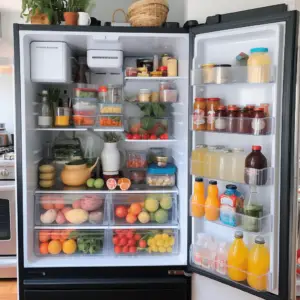Long-Term Storage, Refrigerators provide immeasurable value in any kitchen whether commercial or domestic and demand very little care and maintenance.
As long as a fridge is in good working order it should continue to serve you wholly for over ten years sometimes making it to the two-decade mark.
It is rare that you find yourself ever needing to decommission your fridge and set it aside for any reason let alone for any length of time. Once plugged in, the fridge stays plugged in and powered up for years.
At some juncture, though, you may find that you have to leave your home for an extended period of time. You will have to put away your electrical appliances.
This is easy with most appliances as you regularly plug them in. Simply pack these in boxes and store. Your refrigerator cannot be put away easily and may cost you the whole thing.
How long a refrigerator may be stored without being used depends on how well you follow the manufacturer’s long-term storage guidelines. While model preparation for storage may vary, the essential rules are same.
Table of Contents
So How long can a refrigerator be stored without being used?

If you are planning to be gone for a few weeks or a few months, it would be ok, even advisable to leave the fridge plugged in and running.
Modern refrigerators consume significantly less power and if you declutter the refrigerator and set your controls to the lowest calibrations, the refrigerator should be just fine once you get back.
The amount of power consumed should not make much difference to your electricity bill. Maybe you do not intend to leave any power running to the house. Maybe you want to pack the refrigerator away in a storage space where there is no power such as the basement, or you intend to be gone for much longer.
The following is what you need to do to ensure your fridge will run as efficiently as it does once you power it up again.
Prepping a refrigerator for long-term storage
- Remove all food currently in the fridge and dispose of it. Remove all frozen food in the freezer as well and discard it.
- At the back of the refrigerator, find the water supply line and disconnect it or turn it off.
- Remove the ice from the ice maker.
- Leave the refrigerator empty but running overnight or for at least a full day to allow any water in the refrigerator to finish a cycle after which you should remove the ice.
- If your refrigerator has a water dispenser, empty the tank. Your user’s manual should have instructions specifically for your model since different models will have different dispenser designs.
- Dial down the refrigerator controls to OFF. Unplug the fridge.
- Let the refrigerator sit for a few hours allowing it to get down to room temperature.
- Clean the fridge thoroughly.
Best way to clean a refrigerator for long-term storage
While plugged in and cooling constantly, your refrigerator harbors many microorganisms, but at room temperature, they become active, causing an odor after unplugging and letting it sit for a few hours.
If even more time passes, the odor should worsen and some surfaces should begin to form slime and in days, grime and mildew will begin to grow.
If you don’t clean the fridge well, you’ll find mold and mildew when you open it. A fridge with microorganisms will be irreparable after a year.
- Remove all removable pieces and set them aside.
- In a bucket of warm water, put dishwashing soap and with a soft cloth that will not corrode, wash the sides or walls of the fridge and do the same with the freezer.
- Ensure you clear out any stuck food particles and leave the cavity clean.
- Put plain water in a bucket and wipe down the fridge leaving it dry.
- Dilute half a cup of vinegar in about half a bucket of water. Wipe down the inside of the fridge thoroughly and repeat the same with the freezer compartment.
A refrigerator for long-term storage

- Use the vinegar solution to clean the doors and the insulation folds thoroughly.
- Clean the insulation folds carefully so as not to dislodge them.
- Leave the refrigerator open and proceed to clean the removable surfaces in warm water and dish soap.
- Rinse them out and wipe them down with the vinegar solution. Ensure that every surface is thoroughly wiped and dried.
- Replace the removable surfaces in the refrigerator.
- Open two boxes of baking soda and place them in the refrigerator and freezer. Do not close the doors but do not leave them ajar either.
- Instead, drape a towel on the doors so that they are not wide open but not closed completely either.
- Allow the baking soda to sit like this in the fridge and freezer to combat any mold spores and kill any remaining micro-organisms.
After three or four days like this, you can move the refrigerator into your preferred storage space. To protect it further, cover the fridge with a waterproof polythene sheet to keep out precipitation and even dust.
Refrigerators are incredibly hardy machines and the only real danger with long-term storage is likely to come from the inside of the refrigerator if it had not been thoroughly cleaned out.
The air-tight compartments are an excellent hub for mold and mildew growth when it is not cooling. Mold is invasive and could grow into the interior of the refrigerator.
There is no way to recover your fridge if this happens and even if you could have it repaired, your refrigerator could be prone to breaking down soon after you have retrieved it. If no mold forms, your refrigerator will work perfectly even after a few years.


